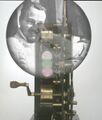Template:Selected anniversaries/December 25: Difference between revisions
No edit summary |
No edit summary |
||
| Line 8: | Line 8: | ||
File:Claude Chappe.jpg|link=Claude Chappe (nonfiction)|1763: Inventor [[Claude Chappe (nonfiction)|Claude Chappe]] born. He will invent and develop a practical semaphore system that will span all of France -- the first practical telecommunications system of the industrial age. | File:Claude Chappe.jpg|link=Claude Chappe (nonfiction)|1763: Inventor [[Claude Chappe (nonfiction)|Claude Chappe]] born. He will invent and develop a practical semaphore system that will span all of France -- the first practical telecommunications system of the industrial age. | ||
||Francesco Maria Zanotti Cavazzoni dies ... philosopher and writer. His 1741 essay on the 'attractive force of ideas' defended a view of the association of ideas influenced by Newtonian physics. | ||1777: Francesco Maria Zanotti Cavazzoni dies ... philosopher and writer. His 1741 essay on the 'attractive force of ideas' defended a view of the association of ideas influenced by Newtonian physics. | ||
||1831: The Great Jamaican Slave Revolt begins; up to 20% of the island's slaves mobilize in an ultimately unsuccessful fight for freedom. | ||1831: The Great Jamaican Slave Revolt begins; up to 20% of the island's slaves mobilize in an ultimately unsuccessful fight for freedom. | ||
| Line 27: | Line 27: | ||
||1906: Ernst Ruska born ... physicist and academic, Nobel Prize laureate. | ||1906: Ernst Ruska born ... physicist and academic, Nobel Prize laureate. | ||
||1927: Ichirō Satake born ... mathematician working on algebraic groups who introduced the Satake isomorphism and Satake diagrams. He was considered an iconic figure in the theory of linear algebraic groups and symmetric spaces. Pic. | |||
||1929: Percy Alexander MacMahon dies ... mathematician, especially noted in connection with the partitions of numbers and enumerative combinatorics. Pic. | ||1929: Percy Alexander MacMahon dies ... mathematician, especially noted in connection with the partitions of numbers and enumerative combinatorics. Pic. | ||
| Line 50: | Line 52: | ||
||1973: Gabriel Voisin dies ... aviation pioneer and the creator of Europe's first manned, engine-powered, heavier-than-air aircraft capable of a sustained (1 km), circular, controlled flight | ||1973: Gabriel Voisin dies ... aviation pioneer and the creator of Europe's first manned, engine-powered, heavier-than-air aircraft capable of a sustained (1 km), circular, controlled flight | ||
||1975: Gunnar Kangro dies ... mathematician and author | ||1975: Gunnar Kangro dies ... mathematician and author. | ||
||1991: Mikhail Gorbachev resigns as President of the Soviet Union (the union itself is dissolved the next day). Ukraine's referendum is finalized and Ukraine officially leaves the Soviet Union. | ||1991: Mikhail Gorbachev resigns as President of the Soviet Union (the union itself is dissolved the next day). Ukraine's referendum is finalized and Ukraine officially leaves the Soviet Union. | ||
Revision as of 11:23, 4 October 2018
1642: Isaac Newton born. He will be widely recognized as one of the most influential scientists of all time and a key figure in the scientific revolution.
1730: Physician and activist Filippo Mazzei born. He will act as an agent to purchase arms for Virginia during the American Revolutionary War.
1763: Inventor Claude Chappe born. He will invent and develop a practical semaphore system that will span all of France -- the first practical telecommunications system of the industrial age.
1932: Enrico Fermi computes probability set for path Santa Claus will travel.
1956: John Brunner uses scrying engine to extract cryptographic numen from Hellscreiber transmissions.
2016: Astronomer and academic Vera Rubin dies. She discovered the discrepancy between the predicted angular motion of galaxies and the observed motion, by studying galactic rotation curves.
2017: Swirl is voted Picture of the Day by the citizens of New Minneapolis, Canada.






